During the Second World War there were numerous aircraft crashes in and around Chipping Norton, mostly from the Operational Training Units and Flying Schools operating from nearby airfields. Below are those discovered so far;
18th January 1940: North American Harvard Mk I N7144 from 2 Service Flying Training School from RAF Brize Norton was engaged in an instrument flying sortie. At around 0930 the aircraft descended below the briefed height of 2,000 feet and attempted to join another formation. Whilst doing so the aircraft stalled, entered a spin and had insufficient height to recover. It hit trees and crashed near Chipping Norton.
Pilot Officer Arthur John Mullock, Royal Air Force,who was at the controls, was killed. He was aged 18 and is buried in Whitchurch Congregational Chapelyard in Shropshire. The safety pilot survived the crash.
.jpg?timestamp=1555484057012)
3rd July 1940: Airspeed Oxford Mk 1 R6266, of 15 Flying Training School collided with a parked Oxford, N4580, whilst taking off at Chipping Norton airfield.
Flight Sergeant Roderick George Morison, Royal Air Force, aged 24, piloting R6266 was killed. He was born in Richmond, Surrey to parents Roderick and Ruth Morison and is buried in Chipping Norton cemetery. His three passengers survived the crash.
.jpg?timestamp=1555484057012)
9th July 1940: Airspeed Oxford Mk 11 P1890, with the pilot flying solo, collided with Oxford Mk 1 N6326 in mid-air, both aircraft crashing near Charlbury. Both aircraft were from 15 Flying Training School and had taken off from Chipping Norton airfield.
Sergeant Gerald James Parr, Royal Air Force Volunteer Reserve, was killed, aged 20 and is buried in Sutton Cemetery. The pilot of the other Oxford parachuted to safety.

.jpg?timestamp=1555484057012)
27th August 1940: North American Harvard Mk 1 P5850 from 6 Service Flying Training School at Little Rissington was undertaking solo aerobatics when the aircraft stalled in a turn and dived into the ground at Kingham Hill.
Sergeant Harry Williams, Royal Air Force Volunteer Reserve, aged 26 was killed. He was the son of Arthur and Bessie Williams of Warmley, Gloucestershire and is buried in Warmley Tower Unity Methodist Church Burial Ground.
.jpg?timestamp=1555484057012)
7th November 1940: North American Harvard Mk 1 N7008 from 15 Flying Training School spun into the ground 2 miles west of Chipping Norton, killing both aircrew;
Flying Officer Willliam Ronald Corkhill, Royal Air Force, aged 25, he was the son of Captain Thomas Walter Corkhill and Bessie Victoria Corkhill, of Llanfair Dyffryn Clwyd, Denbighshire. He is buried in Woodstock Churchyard.
Aircraftman 1st class John Gundy Humphrey, Royal Air Force Volunteer Reserve, aged 22, he was the son of Arthur and Lily Humphrey of Gravesend. He lived in Sittingboure, Kent and is buried in St Laurence Cemetery in Bapchild, Kent.
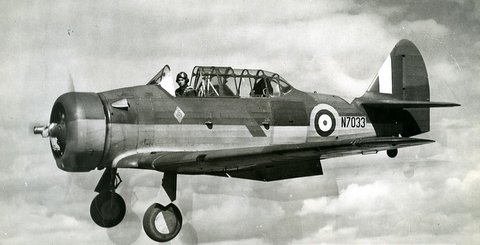
.jpg?timestamp=1555484057012)
3rd August 1941: Airspeed Oxford Mk1 V3244 of 2 Flying Training School whose pilot was flying solo night circuits when he encountered poor weather, forcing him to fly at low level and causing him to fly into high ground 1/4 mile south of Chipping Norton.
Leading Aircraftman Leonard George Washington, Royal Air Force Volunteer Reserve, was killed aged 33. He was the son of Frederick and Florence Washington of Sanderstead, Surrey and before the war worked a a clerk for Devonshire & Co, travelling frequently to the United States and South America. He is buried in St Mary's churchyard in Black Bourton.
.jpg?timestamp=1555484057012)
26th August 1941: Airspeed Oxford Mk 1 T1043 from 6 Flying Training School was being flown on an authorised instrument flying sortie when at about 2,000 feet the port mainplane fractured. The aircraft broke up as it crashed at Ditchley Park. The crew did not help their chances of survival as one was not wearing a parachute and the other's harness was not fastened and both aircrew were killed.
Leading Aircraftman Rudolf Herland, Royal Norwegian Air Force, pilot instructor attached to 6 FTS, was aged 24. His body was repatriated to Norway after the war.
Leading Aircraftman Vincent Chester Stewart Rhodes Newman, Royal Air Force, pilot under training, aged 29. He is buried in Little Rissington Churchyard.
He was married to Margaret and lived at 12, Oaklands, Isleworth, Middlesex, where he had worked as a bus driver. He had been commissioned into the Royal Marines as a 2nd Lieutenant, pictured below, on 7th December 1939, serving on the Chatham Division. He then transferred to the Royal Air Force in 1940 to train as a pilot.
.jpg?timestamp=1555484057012)
18th September 1941: Airspeed Oxford Mk 11 V73783 of 6 Service Flying Training School, Little Rissington. The pilot was undertaking a solo sortie of singe engine flying whe he allowed the aircraft to lose speed in a flat turn and it entered a spin and crashed at Chipping Norton airfield.
Leading Aircraftman Peter Reynolds West of the Royal Air Force, was killed. He was 22 and the son of William Reynolds and Adeline West, of 41, Lowther Drive, Enfield, Middlesex and attended Minchenden Grammar School between 1935 and 1937. He is buried in Little Rissington Churchyard. The instructor was criticised for allowing LAC West to fly solo, as on past asymmetric flying he had allowed his aircraft to get in a spin.
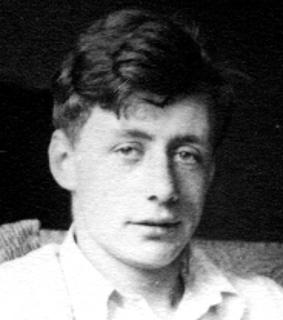
.jpg?timestamp=1555484057012)
14th October 1941: Vickers Wellington serial no R1654 of 22 Operational Training Unit took off from Wellesbourne for a navigation exercise. Encountered poor weather conditions and while flying in cloud lost control and dived into the ground at 1044 not far from the Gloucestershire-Oxfordshire border about 1 mile west of Cornwell, 3 miles west of Chipping Norton. Five aircrew were killed.
Sergeant William Leslie Falardeau, aged 19, pilot, Royal Canadian Air Force. He is buried in Little Rissington churchyard and was the son of Earl and Hilda Falardeau of Winnipeg, Canada.
William Leslie Falardeau was a camera grip on the 1940 Powell and Pressburger film "49th Parallel" and also played an aviator on the rescue float plane as it arrives at Cape Wolstenholme (below right). In the film, he was shot and apparently killed by the Nazis before they commandeered the aircraft. A second role for him was as a double for Raymond Massey in a few scenes. He died before the film was released. He had been a keen aircraft enthusiast and won cups for his model planes. He joined the Royal Canadian Air Force in November 1940 and left for England in August 1941.
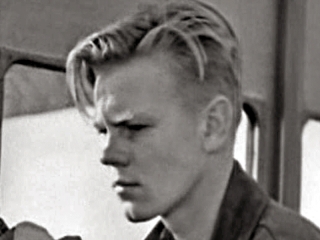
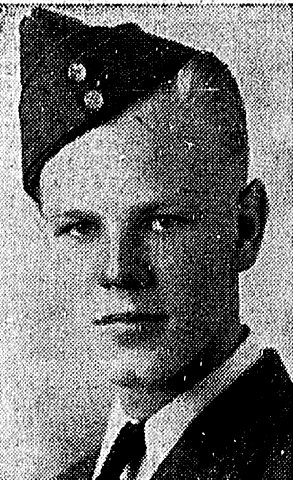
Sergeant Bill Ingalls Hoese, aged 26, Royal Canadian Air Force. He is buried in Little Rissington churchyard and was from Worthington, Indiana, USA.
Sergeant Leslie Bernard Woodfield aged 20, Royal Air Force Volunteer Reserve. He is buried in Birmingham Lodge Hill Cemetery and was the son of Arthur and Ellen Woodfield of Birmingham.
Sergeant Ronald Mcnamara, aged 24, wireless operator/air gunner, Royal Air Force Volunteer Reserve. He is buried in Cranston St Dunstan's Cemetery in Middlesex.
Sergeant Alfred Hildebrandt, aged 28, air gunner, Royal Air Force Volunteer Reserve. He is buried Wallsall Bloxwich Cemetery and was the husband of Daisy.
.jpg?timestamp=1555484057012)
23rd December 1941: Vickers Wellington Mk 1c DV422 of 21, Operational Training Unit took off from RAF Edgehill for general handling practice. While demonstrating stalling and recovery the aircraft went into a dive and at 1420 crashed and burned near Wild Spring Farm, Little Tew, 5 miles east-north-east of Chipping Norton with the loss of 6 crew;
Squadron Leader Reginald George Williams DFC AFM, pilot, Royal Air Force, aged 35. He is buried in Moreton-in-Marsh Cemetery.
Reginald Williams serving as a Flight Sergeant pilot with 99 Squadron when was awarded the Air Force Medal. It was for his actions whilst flying as 2nd pilot on a Handley Page Harrow on 6th October 1938. At about 10 miles of the South coast the aircraft was struck by lightening and a 150 gallon fuel tank ruptured, flooding the cabin with petrol. They tried to make it to Croydon aerodrome but the port engine faded and the aircraft had to be abandoned, the four crew parachuting to safety.
He was awarded his Distinguished Flying Cross on 31st May 1940 for his exceptional courage and devotion to duty. One example cited was nursing a Vickers Wellington bomber of 99 Squadron back to base on one engine after returning from a bombing raid, pictured below.
He was the leader of A flight at 21 OTU and in July 1941 had successfully force landed a stricken Wellington at RAF Edgehill.
Pilot Officer Sidney Crump, pilot, aged 26 of the Royal New Zealand Air Force. He is buried in Moreton-in-Marsh Cemetery and was the son of Harry and Lily Crump, of Feilding Wellington, New Zealand.
Pilot Officer Ian Curtis Grant, pilot, aged 23 of the Royal New Zealand Air Force. He is buried in Moreton-in-Marsh Cemetery and was the son of Ian and Myrtle Grant, of Inglewood, Taranaki, New Zealand.
Pilot Officer Reginald John Hopkins, air gunner, aged 24. He is buried in Brookwood Cemetery, Surrey and was married to Barbara Dawn Hopkins, of Manor Park, Essex.
Flight Sergeant Ronald Ivor Peach, wireless operator/air gunner, aged 20. He is buried in Sheffield Shiregreen Cemetery and was the son of Joseph and Nancie Peach.
Sergeant Howard Gordon Kelly, air gunner, aged 20. He is buried in Maltby Cemetery and was the son of Fred and Maud Kelly of Maltby, South Yorkshire.

.jpg?timestamp=1555484057012)
7th February 1942: Airspeed Oxford Mk 11 AP475 of 6 Flying Training School crashed within a few minutes of taking off from Chipping Norton Airfield on a night dual training sortie, coming down at Castle Farm, Heythrop and killing both aircrew.
Pilot Officer William Milne, pilot instructor, Royal Air Force, aged 27, he is buried in Dundee Crematorium.
Leading Aircraftman Harold Normand Gladman, pilot under training, Royal Air Force, aged 21. He was the son of Henry and Adelaide Gladman of West Green, Middlesex and is buried in Tottenham Cemetery.
The pilot who had previously flown this aircraft had reported difficulties in getting the Oxford to turn to port and that the undercarriage lights were not giving proper indications. The aircraft was not not placed unserviceable and this may have been a contributing factor in the crash. The officer in charge of night flying was criticised for not having the reported faults examined.
.jpg?timestamp=1555484057012)
15th May 1942: Airspeed Oxford AP476 of 6 (Pilot) Advanced Flying Unit based at Little Rissington crashed at Glyme Farm near Chipping Norton Relief Landing Ground. After an apparent engine failure from about 40 degrees out of wind and at a low speed. When it was about 300 yards from the airfield it turned downwind and crashed into trees, killing all three aboard;
Flying Officer Ronald Henry Imeson, Royal Air Force Volunteer Reserve, pilot instructor, aged 21. He was the son of Frank and Annie Imeson, of Hayes, Kent and is buried in Little Rissington churchyard.
He had worked in the civilian staff section of the Metropolitan Police for the S1 (firearms branch) at Scotland Yard since August 1939. As a member of the RAFVR he was called up in August 1940. He was commissioned in May 1941 and was posted to 6 FTS from No 2 Central Flying School in July that year. He was promoted to acting Flying Officer on 31st December 1941.
Sergeant John James Carthew, Royal Air Force Volunteer Reserve, pilot, aged 25. He was the son of James and Annie Carthew of Dumbarton and is buried in Dumbarton cemetery.
Sergeant Walter Fox, Royal Air Force Volunteer Reserve, pilot, aged 24. He was the son of Henry and Liza Fox and married to Marion Fox, all of Penarth, where he is buried.
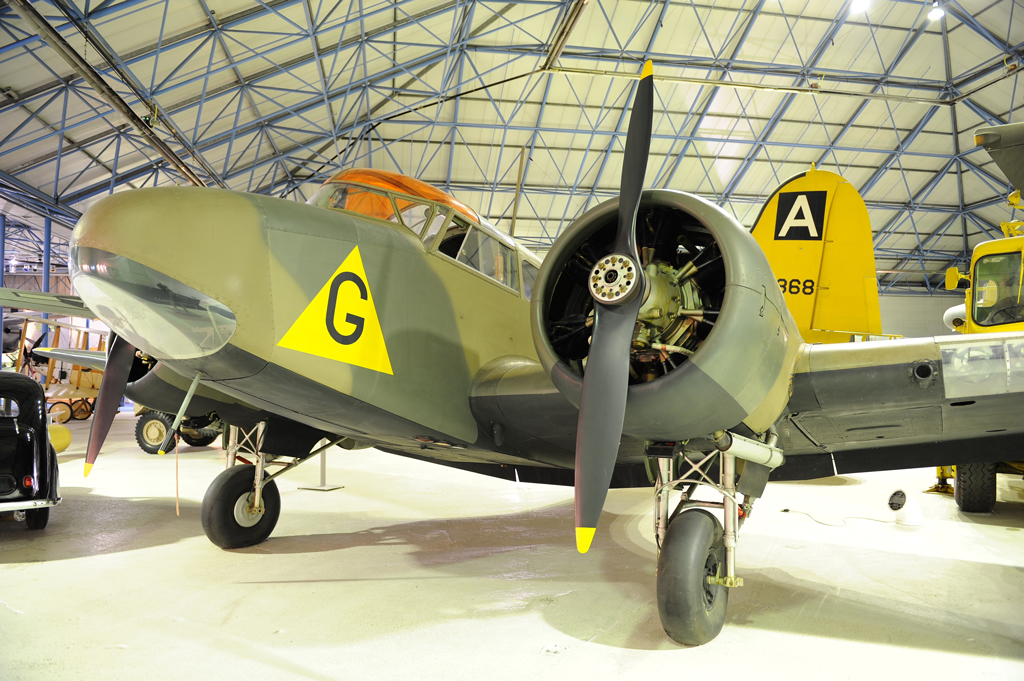
.jpg?timestamp=1555484057012)
21st May 1942: Avro Anson Mk1 N2529 of 21 Operational Training Unit took off from RAF Moreton-in-Marsh on a low-level cross-country training flight. The aircraft hit a line of high tension power cables 1 mile east of Kingham and 4 miles south-west of Chipping Norton. Two crew members were killed;
Flight Sergeant Edmund Verner Shaw, aged 22, pilot Royal Air Force Volunteer Reserve. He is buried in Dundonald Cemetery, Belfast and is the son of Edmund and Mary Shaw, of Belfast.
Sergeant Ernest Brocklebank, aged 27, observer, Royal Air Force. He is buried in Moreton-in-Marsh Cemetery and was the husband husband of Olive Claire Brocklebank, of Hengoed, Glamorgan.
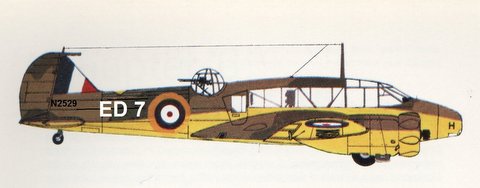
.jpg?timestamp=1555484057012)
25th May 1942: Airspeed Oxford Mk 1 T1264 of 6 Pilot Advanced Flying Unit was landing at Chipping Norton airfield after local flying practice, in conditions of strong wind and bumpy air flow. At first touchdown the aircraft bounced heavily and the pilot opened up to go round again. It is thought he raised the flaps to quickly and too low an altitude, the aircraft lost height rapidly and crashed on the Burford Road.
An Air Cadet from 136 Squadron ATC Chipping Norton had gone to the airfield hoping for some flying experience. He recalls;
"I approached a sergeant pilot who was walking out carrying a parachute and asked if there was a chance of a flight. He replied "No, as I am going up on an air test. Come and see me later".
"I spent some time in the crew room watching the aircraft movements, when the aircraft the Sergeant was in came in to land. There was a certain amount of wind and his approach was a trifle high. He came in touched down and bounced a couple of times and I remember saying he's up, he's down. A Canadian in the crew room commented "for so-and-so sake make your mind up". The aircraft took off again and made another circuit before turning to cross the Burford Road passing over The Albion Tavern. At this point the wing dropped and the aircraft slid sideways and crashed between two houses opposite the Tavern. The pilot died a short time after the crash and I had a lucky escape from a simple 'No'."
The aircraft had crashed up against Mr Miles house. He was a teacher at the local Grammar School and his wife remembers;
"It was a very stormy wet and windy Whitsun Bank holiday in 1942, and we were surprised that flying was allowed at the RAF training camp along the Burford Road in such conditions. Suddenly with a terrific roar a trainer landed outside my kitchen window where I was working. The fruit trees in its course were destroyed and the engines were thrown through the hedge and into the side of the house next door where they did heavy damage. There is still a red mark on the side of our house where the unsupported part of the wing struck-a few inches further and the whole wall of the house would have been destroyed along with the people inside it"
Sergeant Bernard Williams, pilot, Royal Air Force was killed, aged 22. He was the son of Alfred and Mary Williams of Leeds and is buried in Leeds Roman Catholic Cemetery.
.jpg?timestamp=1555484057012)
12th June 1942: Vickers Wellington Mk1c Z1177 of 12 Operational Training Unit took off from RAF Chipping Warden for a cross-country night training exercise. At 0200 the aircraft became iced up and stalled, crashing at Conduit Farm, Churchill killing all the crew;
Pilot Officer Warren Percy Bolton, (below), aged 23, pilot Royal Air Force. He is buried at Brookwood Military Cemetery and was the son of John and Edith Bolton, of Chicago, Illinois, USA.
 (1).jpg?timestamp=1560326503688)
Pilot Officer Bede Joseph Stourton Vavasour aged 19, observer Royal Air Force Volunteer Reserve. He is buried in Creswell St Mary's Roman Catholic Churchyard and was the son of Oswald Joseph and Mary Dorothy Vavasour, of Draycott-in-the-Moors.
Pilot Officer Alfred James Majury aged 23, wireless operator/gunner Royal Air Force Volunteer Reserve. He is buried in Sutton Bridge St Matthew Churchyard and was the husband of Gwendoline Majury, of Sutton Bridge.
Sergeant John Ernest Counihan aged 26, wireless operator/gunner, Royal Air Force Volunteer Reserve. He is buried in Brookwood Military Cemetery, Surrey and was the husband of Mary Counihan, of Ealing, Middlesex.
.jpg?timestamp=1555484057012)
24th July 1942: Airspeed Oxford I DF293, from 6 (Pilot) Advanced Flying Unit took off from Chipping Norton on a night flying exercise. Shortly after take-off it plunged into the ground near the airfield at high speed after the pilot lost control.
Sergeant David Gordon Henderson of the Royal Canadian Air Force was killed. Hewas aged 22 and the son of David Gauld Henderson and Ann Henderson, of Edmonton, Alberta, Canada. He is buried in Little Rissington Churchyard.
It was considered that his lack of experience on the type, coupled with no recent instrument flying contributed to the accident.
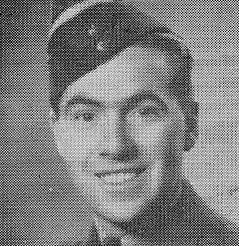
.jpg?timestamp=1555484057012)
21st August 1942: In the early hours a Vickers Wellington bomber and an Airspeed Oxford trainer were involved in a mid-air collision North-West of Chipping Norton over open country. The Oxford was on a pilot training flight from No 6 Advanced Flying Unit, Little Rissington, whilst the Wellington was on a crew night training flight from No 15 Operational Training Unit based at Harwell. Both aircraft were destroyed by the impact. All 7 crew in the Wellington and 2 in the Oxford died.
.jpg?timestamp=1555484057012)
8th November 1942: Vickers Wellington Mk 1c R1777 from 21 Operational Training Unit took off from RAF Moreton in Marsh on a cross-country training exercise with instructions to land back before dusk. The crew were unaware of their position and at 1900 touched down at RAF Chipping Norton but hit an obstruction, writing the aircraft off. The pilot was Pilot Officer J S Ambler and he and his crew were not seriously injured.

.jpg?timestamp=1555484057012)
9th November 1942: Airspeed Oxford AB694 from 6 (Pilot) Advance Flying Unit took off from RAF Chipping Norton at 0350 on a night training flight. It hit trees shortly after take off and crashed to the ground, killing both occupants. An investigation found that aircraft elevator trim wheel may have been incorrectly set for take-off. The crew were:
Flight Lieutenant Howard George Kallend, flying instructor, Royal Air Force Volunteer Reserve, aged 30. He is buried in Wellington, Somerset and was the son of Samuel Wilfred and Beatrice Emily Kallend, of Wellington. He worked as a rep for a furniture company and was a member of the Civil Air Guard before joining the RAFVR.
Sergeant James Greenall, pupil pilot, Royal Air Force Volunteer Reserve, aged 23. He is buried in Hurst Green Cemetery and was the son of James and Rhoda Greenall of Dutton. He had been an articled clerk before the war.
.jpg?timestamp=1555484057012)
3rd March 1943: Vickers Wellington BK400 from 12 Operational Training Unit took off from RAF Chipping Warden at 1040 for a cross-country training flight. At 1255 the pilot lost control in cloud and crashed just under 2 miles south-west of Little Tew, 3 miles east-south-east of Chipping Norton with the loss of 6 aircrew;
Flight Lieutenant Edward Devereux Spratt, pilot, Royal Air Force Volunteer Reserve, aged 30. He is buried in High Hurstwood Sussex, and was the son of Colonel Edward and Alice Spratt. He married Isla Hamilton, who had gained Royal Aviator's Club Certificate in 1936 and lived at Merrowdown, Harlequin Lane, Crowborough. They had a son Robin, his wife had died previously in 1941. He had done a tour of duty with Coastal Command before joining 12 OTU.
Pilot Officer Stanley Walker Shepherd, navigator, Royal Air Force Volunteer Reserve, aged 22. He is buried in Ecclesall, Sheffield and was the son of Beatrice Shepherd.
Stanley Walker joined the Metro-Vicker's Company as a School Apprentice in October 1936 and joined the RAF in July 1940 and commissioned as a Pilot Officer in 1942.
Sergeant Vaughan Stacey Allen, air gunner, Royal Air Force Volunteer Reserve, aged 19. He is buried in Birmingham Witton cemetery and was the son of Frederick and Mabel Allen of Erdington, Birmingham.
Sergeant Arthur Frederick Ash, air gunner, Royal Air Force, aged 25. He is buried in Fulham Palace Road Cemetery and was the son of George and Mabel Ash of Baron's Court.
Sergeant James Albert Willis, wireless operator/air gunner, Royal Air Force Volunteer Reserve, aged 21. He is buried in Nottingham Northern Cemetery and was the son of Albert and Lily Willis of Hyson Green, Nottingham.
Sergeant Alexander Rennie Burgess, bomb aimer, Royal Air Force Volunteer Reserve, aged 22. He is buried in Saline Cemetery and is the son of Robert and Christina Burgess of Saline, Fifeshire.
.jpg?timestamp=1555484057012)
15th April 1943: Vickers Wellington Z1142 suffered a burst tyre and swung off the runway while taking off at RAF Enstone. The aircraft hit the windsock and crashed in flames killing three of the crew.
Flying Officer Geoffrey Henry Druce, air bomber, Royal Air Force Volunteer Reserve aged 20. He is buried in Reading Henley Road Cemetery and was the son of John and Ethel Druce of Caversham, reading.
Sergeant Charles Alfred Good, pilot, Royal Air Force Volunteer Reserve, aged 26. He is buried in Douglas Cemetery in the Isle of Man and was the son of Charles and Bessie Good of Douglas.
Sergeant Frank Townsend, pilot, aged 20. He is buried in Streatham Park Cemetery and was the son of Ernest and Edith Townsend of Clapham Common.
Sergeant Cecil Rhodes, air gunner, Royal Australian Air Force suffered fromsevere burns to his face scalp and hands, and taken to Banbury hospital. He was then admitted to Queen Victoria Hospital in East Grinstead under the care of Archibald McIndoe, the pioneering plastic surgeon. He was promoted to Flight Sergeant whilst in hospital in March 1943. His condition gradually improved and in September 1943 he was offered a free radio engineering course by the BBC, which he took up. He was discharged to Marchwood Convalescent Home but still under treatment by Mr McIndoe having a number of operations. He was promoted to Warrant Officer in March 1944 and had improved sufficiently that a return to ground crew service was considered after further sick leave.He was however recommended for repatriation to Australia and returned to Sydney on the SS Aquitania arriving on 28th November 1945. on arrival he was admitted to No3 RAAF Hospital in Sydney. Sadly died there on 21st May 1946 aged 23 from complications caused by his injuries. He is buried in the Sydney War Cemetery.

.jpg?timestamp=1555484057012)
1st May 1943: Vickers Wellington Mk 1c N2847 of 21 Operational Training Unit took off from RAF Enstone on a night training exercise. The aircraft suffered a hydraulic failure and landed back at the airfield at 0230, without flaps working and bounced, crashed and was destroyed by fire. Pilot Officer F. Temple and Sergeant R. Hayward were injured.
.jpg?timestamp=1555484057012)
26th June 1943: B-24 42-63762 Hells Express of 409 Bomb Squadron, 93rd Bomb Group crashed at Little Compton. The aircraft suffered a double engine failure when flying from Hardwick to Portreath. The pilot attempted to force-land amongst the hills. It was joining the remaining B-24s in England to fly to North Africa for the famous Ploesti raid, having been delayed for a day. 9 aircrew and groundcrew travelling on the aircraft were killed in the crash;
Pilot 1st Lieutenant John Watts Pryor, aged 21, son of Albert and Minerva Pryor of Texarkana, Texas. He was buried in Cambridge American Cemetery before being repatriated and re-interred in Rose Hill Cemetery in Texarkana in 1948.
Co-Pilot 2nd Lieutenant Charles Luther Porterfield, aged 23, the son of David and Jennie Porterfield of Los Angeles. He was buried in Brookwood American Cemetery before being repatriated and re-interred in the Golden Gate Cemetery in San Bruno California in 1948.
Navigator 2nd Lieutenant Harley C Shively, aged 24, he was the son of Harvey and Clementine Shively of Hamilton, Missouri. He is buried in Cambridge American Cemetery.
Bombardier 2nd Lieutenant Jack F Wardell, aged 24, of Alexandria, Minnesot, he had worked as a truck driver before enlisting. He is buried in Cambridge American Cemetery.
Engineer Technical Sergeant Raymond P Cathcart, aged 26, he was the son of Alfred and Clara Cathcart of Westville, Indiana, he enlisted into the USAAF on 23rd December 1941. He was initially buried in Cambridge American Cemetery, but repatriated after the war and re-interred in Westville Cemetery in Indiana.
Assistant Radio Operator Sergeant Edward Herschel Dick, aged 23, He was the son of Smith and Emily Dick of Ferdale, Pennsylvania. He had worked as a salesman before enlisting into the USAAF on 1st July 1941. He served in England between December 1941 and May 1942, completing his tour of duty and returning home. He arrived back in England on 30th March 1943 to join the 409 Bomb Squadron. He was buried in Cambridge American Cemetery but repatriated in 1948 and re-interred in Richland Cemetery, Geistown Pennsylvania.
Master Sergeant John Lotito, (below), aged 23, the son of John and Mary Lotito of Hazleton, Pennsylvania. He had enlisted in the USAAF in December 1941 and joined the 409th Bomb Squadron on 15th June 1942. He was buried in Cambridge American Cemetery but repatriated in 1948 and re-interred in Mother of Grace Cemetery, Hazleton, Pennsylvania.
.jpg?timestamp=1487417748780)
Staff Sergeant George L Parsons.
Staff Sergeant Harold Mason Lane, aged 22, the son of Luke and Faith Lane of Los Angeles. He was working in an aircraft factory when he enlisted into the USAAF on 18th June 1942. He was buried in Cambridge American Cemetery but repatriated in 1948 and re-interred in Forest Lane Memorial Park, Glendale, Los Angeles.
Tail Gunner Master Sergeant Farlan D Glover was seriously injured and died of his injuries in hospital the following day. He was aged 25 and the son of Noble and Lillie Glover of Walker, Alabama and had married Evelyn Green. He was buried in Cambridge American Cemetery but repatriated in 1948 and re-interred in McCormack Cemetery, Dora, Alabama.
The following were injured;
Radio Operator Technical Sergeant George H Bassette,
Assistant Engineer Technical Sergeant Arthur Wesley Prouty, aged 24.
Tail gunner Sergeant Frank H Wolfe aged 19.
Sergeant Sterling E Carper, aged 21

.jpg?timestamp=1555484057012)
27th June 1943: Airspeed Oxford from 20(Pilot) Advanced Flying School based at Kidlington crashed opposite the Albion Tavern in Chipping Norton after a failed landing attempt in windy weather at Chipping Norton relief airfield.
Flight Sergeant Ray Thomas Langley aged 24, pilot Royal Australian Air Force, died at the scene and he is buried at Kidlington Burial Ground. He was the son of William and Margaret Langley of Fullarton Estate, South Australia, and had worked as a bank officer in the Commonwealth Bank of Australia. His initial attempt to join the RAAF was turned down as they had no vacancies. Instead he joined the 10th Battalion of the Volunteer Militia as a Lance Corporal in June 1939. He eventually joined the RAAF in Febuary 1941 and trained and got his wings in Australia before being sent to England on 15th January 1943. He arrived in England on 17th March 1943 and was posted to 6 PAFU.
Mrs Hunt, who lived nearby, was cleaning in the Albion Tavern when she heard a loud bang and saw the aircraft leaning up against the house opposite. She approached the wreck and saw the pilot, who was still alive but badly injured with the joystick column stuck in his chest. He did not survive for long. A few years later the Australian pilot's parents called at her house and asked if their son had suffered. She told them he had not.

.jpg?timestamp=1555484057012)
7th July 1943: Vickers Wellington Mk1c DV698 from 21 Operational Training Unit took off from RAF Moreton in Marsh at 0940, detailed to carry out a cross-country training exercise. At approx 1030 it broke out of cloud near Chipping Norton airfield and collided with Airspeed Oxford LW783 from 6 (Pilot) Advanced Flying Unit which used the airfield as a relief landing ground. The aircraft crashed close together and burnt.
The pilot of the Oxford, Flight Sergeant G Ferguson was injured and all five crew were killed on the Wellington;
Flight Sergeant Robert Humphrey Collis aged 21, pilot of the Royal Australian Air Force. He is buried at Oxford Botley Cemetery (pictured below). He was the son of Cyril and Violet Collis, of Roseville, New South Wales, Australia.

Sergeant Henry Hugh Patrick aged 33, navigator, Royal Air Force Volunteer Reserve. He is buried in Hamilton West Cemetery and was the husband of Marjory Patrick. of Hamilton.
Sergeant Leonard William Bacon aged 21, navigator, Royal Air Force Volunteer Reserve. He was cremated in Mortlake Crematorium and was the son of Frederick and Norah Bacon of Shepherd's Bush, London.
Sergeant Frank Charles Grievson aged 23, observer Royal (Auxillary) Air Force . He is buried in Wimbledon Gap Road Cemetery and was the son of Thomas and Marion Grievson of West Wimbledon.
Sergeant Anthony Edward Deighton Ross aged 21, wireless operator/air gunner, Royal Air Force Volunteer Reserve. He is buried in Moreton in Marsh and he was born in Deptford, Kent and was married to Kathleen Ross of Bromley.
.jpg?timestamp=1555484057012)
22nd July 1943: Airspeed Oxford Mk 11 X7254 from 6(Pilot) Advanced Flying Unit from Little Rissington collided with Oxford N4834 over Over Norton. Both aircraft crashed at Heythrop Park, killing all three crew members;
X7254
Sergeant Peter Rosse Hope, Royal Air Force Volunteer Reserve, Pilot, aged 19.
He was the son of of Sydney and Elsie Hope, of Brighton, Sussex.
Flight Lieutenant Jack Francis Page, Royal Air Force Volunteer Reserve, Navigator, aged 29.
He was the son of Samuel and Lucy Page and husband of Edith Vera Page, of South Ruislip, Middlesex.
They are both buried at Little Rissington, Churchyard.
N4834
Warrant Officer Brian Cochrane Walmsley, Royal Air Force Volunteer Reserve, pilot, aged 23.
He was the son of William and Kathleen Walmsley, of Prestatyn, and is buried there.
.jpg?timestamp=1555484057012)
14th August 1943: Vickers Wellington X 9618 from 21 Operational Training Unit took off from RAF Morton-in-Marsh at 1605 hours at 1605 hours. At 1705 hours the aircraft crashed near RAF Enstone as a result of petrol starvation. There appeared to be a misunderstanding in the orders to manipulate the fuel cocks, as an engine cut and the aircraft dived to the ground less than a mile from the runway and caught fire. Five of the crew were killed and Sergeant Lewis, Air Gunner was slightly injured.
Flying Officer Aubrey James White, aged 24, Pilot of the Royal Australian Air Force. He was the husband of Annie Catherine White, of Alexandria, New South Wales, Australia and they had a daughter together.
He had been working as a machinist and serving with the 35th Battalion The Volunteer Militia when he enlisted into the RAAF on 10th October 1941. He was sent to Canada on 29th July 1942 to train as a pilot with 4 Service Flying Training School at Saskatoon. He received his flying badge on 20th December 1942 and commissioned as a Pilot Officer on 30th. He arrived in the UK on 4th February 1943 and continued his training with 20 (Pilot) Advance Flying unit at Kidlington and was promoted Flying Officer on 30th June 1943. He was posted to 21 OTU on 6th July 1943.
He was nicknamed " Honest Abe".

Flying Officer Harry Malcolm Beyer, aged 20, navigator of the Royal Australian Air Force. He was the son of John and Harriet Beyer, of Lugarno, New South Wales, Australia.
Sergeant Francis Ira Hardaker, aged 23, navigator of the Royal Australian Air Force. He was the son of William John Francis and Eulalie Sarah Hardaker, of Maroubra, New South Wales, Australia.
Flight Sergeant Leonard George Sellen, aged 22, wireless operator/air gunner of the Royal Australian Air Force.He was the son of Charles and Josephine Sellen, of Quandialla, New South Wales, Australia.
Sergeant James Duffey Clarke, aged 20, bomb aimer, Royal Air Force Volunteer Reserve. He is buried in Southampton St Mary Extra Cemetery and was the son of Harry and Margaret Clarke of Southampton.
The four RAAF members who lost their lives are buried at the Oxford Botley Road Cemetery (pictured below). The tail gunner Flying Officer A. J. White escaped serious injury.
.jpg?timestamp=1555484057012)
16th November 1943: Vickers Wellington Mk 1c, DV918, from 21 Operational Training Unit took off from RAF Enstone at 2010 to carry out a training exercise. The aircraft crashed ten minutes later in the circuit of Enstone airfield, at Hookerswell Farm on south-east side of Little Tew. It was thought that the pilot may have been a little bit premature in raising the flaps, thus losing valuable height while still close to the ground. Four of the crew were killed and Sergeant Selby, air gunner, was injured.
Flight Sergeant Samuel Harrington Thrower, aged 30, pupil pilot of the Royal Australian Air Force. He is buried in Oxford Botley Road Cemetery and was the husband of Zena Margaret Thrower, of Wooloowin, Queensland, Australia.
Flying Officer Walter Roderick Matheson, aged 22, bomb aimer, Royal Air Force. He is buried in Sandwick Cemetery in Ross and Cromarty and was the son of Walter and Annabella Matheson, of Stornoway.
Walter Matheson joined the RAF before the war. He served for a time as a wireless operator, but was selected for a commission and sent to Canada for training. His selection was well merited and shortly after his return to this country with the rank of Pilot Officer, he was promoted Flying Officer. While still at school he had made a name for himself as a Gaelic singer.
Sergeant Douglas William Pike, aged 22, navigator, Royal Air Force Volunteer Reserve. He is buried in Leeds Harehill Cemetery and was the husband of Joyce Pike of Leeds.
Sergeant Walter Douglas Cole, aged 20, Wireless Operator/Air Gunner, Royal Air Force Volunteer Reserve. He is buried in Bideford Church Cemetery in Devon and was the son of Alfred and Lottie Cole of Stoneygate, Leicestershire.
A Court of Inquiry into the accident stated : “ The aircraft was engaged on local night circuits and landings and the accident occurred after one hours flying. The Pilot had received one check circuit from a Screened instructor who had then watched him do two further circuits solo. On the third circuit the aircraft opened up at about 100 feet to go round again, but it crashed one mile from the flare path".
The Group Captain commanding RAF Moreton-in-Marsh stated : “The accident was due to inexperience and to the advent of a sudden emergency. The possible failure of the engines is being investigated, but the circumstances of the accident point to insufficient air speed and a possible “Dorn Drop” of air from the crest of the hill facing the runway.”
.jpg?timestamp=1555484057012)
11th December 1943: Vickers Wellington LN531 of 16 Operational Training Unit took off from Upper Heyford at 1728 on a night cross country training flight. The aircraft emerged from cloud at 2303 and flew into high ground at Little Rollright killing all the crew.
Flight Sergeant Daniel Ernest Leseberg, aged 21, pilot of the Royal Australian Air Force. He was the son of Ernest Theodore and Ellen Mary Leseberg, of Redcliffe, Queensland, Australia.
Sergeant Eric Harris, aged 19, navigator. He is buried in Diss Cemetery, Norfolk and was the son of Mrs F. Smith of Diss.
Sergeant Viktor Plahte, navigator of the Royal Norwegian Air Force. He was the son of Viktor Plahte, a notable Norwegian businessman and had enlisted in the Norwegian air force in exile in Canada.
Sergeant Henry Mitchell, aged 28, air bomber of the Royal Canadian Air Force. He was the son of Henry John and Elizie Mitchell, of Twin Butte, Alberta, Canada. His brother, James Walton Mitchell, also died on service.
Sergeant Frederick Nichols aged 21, wireless operator/air gunner. He was the son of Bert and Nettie Nichols, of Glasgow.
Sergeant Bernard Redmond, aged 33, air gunner of the Royal Canadian Air Force. He was the son of William and Elizabeth Redmond, of Calgary, Alberta, Canada.
Sergeant John Foote, aged 20, air gunner of the Royal Canadian Air Force. He was the son of Frederick and Jane Foote, of Walkerville, Ontario, Canada.
They are all buried at Oxford Botley Road Cemetery apart from Sergeant Plahte, who was repatriated to his native Norway.
A Flying Accident report stated “The aircraft struck the ground at approx 22 degrees at high speed and it was literally level at the time of impact. Both the engines were running under power at the time. The engines disintegrated and were thrown forward. Also the wing tanks were thrown forward and burnt. The reason for the accident is obscure. The aircraft appeared to fly into the ground at about a 20 degree angle and at high speed, literally level with power on.
.jpg?timestamp=1555484057012)
11th December 1943: Vickers Wellington DV914 from 21 Operational Training Unit took off from RAF Enstone and crashed at 1538 hours. All the crew were uninjured in the crash except Flight Sergeant Albert John Smith, aged 20, bomb aimer of the Royal Australian Air Force who was killed. He is buried in Oxford Botley Road Cemetery and was the son of Thomas and Holly Smith, of Waroona, Western Australia. He had been a farm labourer when he enlisted into the RAAF on 1st March 1942. He was awarded his Air Observer's badge on 7th January 1943 and was posted to the UK, arriving on 7th July 1943. He was promoted to sergeant in August 1943, joining 21 OTU on 12th October that year.

His record states:
"A very good airman who at all times showed very great enthusiasm in all matters regarding his trade as air bomber. He possessed a sound knowledge of his job and his conduct at all times was exemplary."
A Court of Inquiry into the accident stated that : “ The accident occurred just after the Pilot had been dual instruction and had been sent solo by his instructor. As Bassie (the pilot) states he was making his second solo approach when this was obstructed by another aircraft. He opened up and went round again. At approx 690 feet and when immediately over the runway in use, the port engine failed and flames appeared in the engine cowling. The wheels and flaps were up but full boost and RPM was still being used. The Pilot throttled back the engine placed the pitch control to fully coarse and turned off the fuel supply and switches and ordered the Bomb Aimer to press the Graviner switch. When the engine failed the Bomb Aimer asked whether he should abandon the aircraft, but the pilot was too busy to reply. Having completed his drill of immediate action the pilot discovered that the Bomb Aimer was missing. So he lent across and pressed the Graviner switch. The failure of the port engine and subsequent fire compelled the Pilot to make an emergency landing. He made no attempt to lower his undercarriage but contented himself with an efficient wheels up landing. When the bomb aimer disappeared he had not gone to take up his crash station as the Pilot believed, but had opened up the front hatch and abandoned the aircraft. The WAG witnessed the incident, but thinking that the altitude was too low and having received no orders to abandon, he took up his crash position with the other members of the crew. The Air Bomber's chute was fully opened but this did not occur at a height sufficient to save him from fatal injury."
An examination of the engine by a Technical Officer revealed that the No 3 cylinder had fractured circumferentially about four inches from the bottom. The top of the cylinder had lifted , the piston broke up and the front of the engine was covered with oil causing the extensive fire The cause of the engine failure was unknown.”.
The Group Captain commanding RAF Moreton-in-Marsh stated : “ Flight Sergeant Bassie was on his first solo and is to be commended for his coolness in making a safe landing under difficult circumstances. It is evident that the Bomb Aimer abandoned his aircraft without orders from the Captain to do so. His death is clearly due to a flagrant breach of crew discipline.”
.jpg?timestamp=1555484057012)
29th February 1944: Hawker Hurricane L2021 of 63 Operational Training Unit took off from RAF Honiley at 2320 on a night flying excercise. It dived almost vertically into the ground at Barton-on-the-Heath. The pilot, Flight Sergeant Gordon Maxwell Crouch, aged 20 of the Royal Australian Air Force was killed. He is buried in Oxford Botley Road Cemetery. He had worked on his father's farm before enlisting into the RAAF on 8th November 1941. He was mustered as aircrew and sent to Canada for pilot training in July 1942. He gained his flying badge on 5th March 1943 and was posted to the UK on 26th March that year. He was promoted Flight Sergeant serving with 1 Tactical Exercise Unit of 56 OTU at RAF Tealing in Angus. He was then posted to 63 OTU were based at RAF Honiley, near Coventry and to train as a night fighter pilot.

.jpg?timestamp=1555484057012)
10th June 1944: Hawker Hurricane PG425 of 21 OTU crashed into trees at Long Compton killing the pilot Flying Officer Donald Stevens aged 24. He had taken off from RAF Moreton in Marsh at 1005 on a fighter affiliation exercise and crashed at 1125. He was the son of Herbert and Marjorie Stevens of Farnham, Surrey, his father had been deputy director at the RAE Farnborough. He was cremated in Woking.
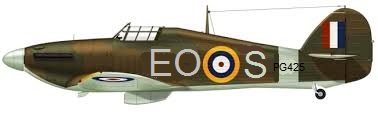
.jpg?timestamp=1555484057012)
14th July 1944: Vickers Wellington, HE381 TY-G, of 24 Operational Training Unit based at Honeybourne spun into the ground at Long Compton.
Flying Officer John Allen Thompson, aged 21, pilot of the Royal Canadian Air Force. He is buried in Brookwood Military Cemetery, Surrey and was the son of Fred and Daisy Thompson and the husband of June Eleanor Thompson, Chilliwack, British Columbia and had one daughter named Jacqueline Dianne.
John Thompson (below) joined the RCAF in June 1941 He graduated as a pilot and received his wings at Macleod, Alberta.

Warrant Officer Robert Burns, aged 24, Wireless operator, Royal Air Force Volunteer Reserve. He is buried in Hawick Wellogate Cemetery and was the son of James Burns and Agnes Burns, of Hawick.
Flight Sergeant John William Johnston, aged 21, air gunner, Royal Canadian Air Force. He is buried in Brookwood Military Cemetery, Surrey and was the son of James and Blanche Johnston, of North Vancouver, British Columbia, Canada.
Sergeant John Anderson, aged 19, Royal Canadian Air Force. He is buried in Brookwood Military Cemetery, Surrey and was the son of John Anderson and Florence Anderson, of Victoria, British Columbia, Canada.
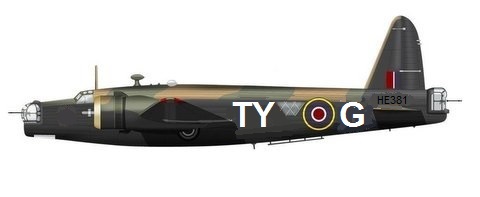
.jpg?timestamp=1555484057012)
16th September 1944: At 00.55 Vickers Wellington LN771 with an instructor and pupil crew were signalled to take off from RAF Enstone at the same time as Wellington LN429 had been given permission to land. A collision occurred on the airfield and both aircraft caught fire and were destroyed after the crews had evacuated. However the wireless operator Sergeant Nevil Luker, 20, unfortunately died from complications brought about by smoke inhalation. The accident was caused by a failure by the airfield controller.
.jpg?timestamp=1555484057012)
23rd December 1944: Boeing B-17 (Flying Fortress) 43-38812 of the 749 Bomb Squadron, USAAF, had diverted to Portreath, Cornwall on 19th December 1944, following a raid on Koblenz. On 23rd December 1944 the aircraft was returning to its base at Glatton in Cambridgeshire, but received orders to divert to an RAF Station, probably Moreton-in-Marsh, as Glatton was fogged in. In the darkness and fog and descending on instruments, it flew into high ground at Great Rollright, near Ascott Farm. The eight crew members who died were;
Pilot 2nd Lieutenant Clifford Hendrickson, below, aged 27 from Jasper, Indiana, the son of Frank and Isabel Hendrickson. He enlisted into the Army Air Force in October 1942 and had flown the Mustang single seat fighter. He was originally buried in Cambridge but was was repatriated to the United States and he was re-interred in Siloh Cemetery, Ireland, Indiana in 1948.

Co-Pilot 2nd Lieutenant Walter Graves, aged 22 from Tennessee, the son of Main and Pearl Graves. He enlisted into the Army Air Force in September 1942. He is buried in the Cambridge American Cemetery.
.png?timestamp=1556090536871)
Navigator Flight Officer Joseph L Kilmer, aged 21, he was born in Chenung in New York State to parents Leslie and Rose Kilmer. He was a clerk when he enlisted into the Army Air Force in February 1944. He is buried in the Cambridge American Cemetery.
.png?timestamp=1556091093911)
Bombardier Flight Officer David E Williams, aged 20, he was the son of David and Beatrice Williams of New Jersey. His body was repatriated to the United States and he is buried in Beverly National Cemetery, Burlington County, New Jersey.
.png?timestamp=1556091207856)
Engineer Sergeant George Henry Bruer, (below), aged 22, he was the son of Henry and Rosalie Bruer of St Johns, Florida, and husband of Ann Bruer. He had enlisted into the Army Air Force in December 1941. Originally buried in Cambridge American Cemetery, his body was repatriated and re-interred in St. Augustine National Cemetery, Florida in October 1948.
.jpeg?timestamp=1487323913107)
Radio Operator Sergeant Robert H Riedel, aged 19, the son of Harry and Irene Riedel of Cuyahoga, Ohio. Robert enlisted June 2, 1943, He graduated from radio operator school at Scott Field April 26, 1944, and won his wings June 29, at Yuma, Arizona. He had been overseas less than a month at the time of his death. Originally buried in Cambridge American Cemetery, his body was repatriated and re-interred in Sunset Memorial Park. Ohio.
.png?timestamp=1556091336471)
Waist Gunner Sergeant George Bruce Hawley, aged 19, Originally buried in Cambridge American Cemetery, his body was repatriated and re-interred in Fort McPherson National Cemetery in Colorado in May 1949.
.png?timestamp=1556091682044)
Ball turret Gunner Sergeant Edmund Thomas Fitzgerald, aged 20, son of Edmund and Ella Fitzgerald of Taunton, Massachusetts. He enlisted into the Army Air Force in July 1943. Originally buried in Cambridge American Cemetery, his body was repatriated and re-interred in Saint Francis Old Cemetery in 1946.
.png?timestamp=1556091961646)
Tail Gunner Sergeant Clifford T Heinrich was badly injured in the crash and spent 14 months in hospital before returning to the United States in February 1946.
.png?timestamp=1556092055929)
Nursing Sister Eluned Megan Lewis of Queen Alexandra’s Royal Army Nursing Corps at nearby Chipping Norton, who was staying at Rollright Manor for Christmas, did what she could for the crew of “812‟ and administered morphine. She was an immensely brave woman. The 812 flew so close to the house and the impact made her think that a German V2 rocket had come in.
In September 2017 I was visited by Mrs Olga Tyler, nee Day, and her husband Terry, who drove up to Kent to tell me the story of her parents. Her story in her own words:
"On the night of 23rd December 1944 I was standing under a bus shelter in Great Rollright, where I lived. I saw a big aeroplane turning and then coming towards me. It was very low, I could see the pilot with two crew standing, looking over his shoulder. It was so low I could have almost touched the bottom. After passing me the aircraft took off the tops of some trees. I heard a crash as it came down near the Rollright stones. I ran to tell my mum and she quickly got on her bicycle and pedalled to the crash site. She pulled two of the crew members from the plane and laid them on the grass. They asked my mum for a cigarette and she got a Woodbine from her pinafore, shortly after which they died. By now my dad had arrived on the scene and he climbed up to pull one of the aircrew in the cockpit out. He asked my dad to tell his Ma that he loved her, before dying. Dad and Mum stayed until the emergency people arrived before leaving.
The Royal Observer Corps post near the Rollright Stones, situated half a mile away, heard the crash and alerted RAF Moreton in Marsh and RAF Chipping Norton who dispatched emergency fire crews.
.png?timestamp=1487331528395)
.jpg?timestamp=1555484057012)
3rd April 1945: De Havilland Mosquito 111 RR291 from 16 Operatiohal Training Unit took off from RAF Upper Heyford at 1635 to carry out combined dual circuit and sigle engined overshoot exercises. The aircraft crashed at Little Tew injuring pilots, Flight Lieutenants Moody and Morgan.
.jpg?timestamp=1555484057012)
8th April 1945: Vickers Wellington BK133, of 21 Operational Training Unit, took off from RAF Moreton in Marsh at 0025 hours, for night solo circuits and landings and single engine approaches and overshoots. The aircraft crashed at 0055 hours near Great Rollright. The aircraft landed after one normal circuit and took off again at 0048 hours. At 0051 hours the pilot called “practice single overshoot”, and about one minute later the aircraft was plotted flying normally at 500/1000 feet, when the engines cut out and almost immediately the aircraft crashed.
It was the opinion of the Investigating Officer into the accident that during single engine flying, the pilot lost height and noticed he was getting close to higher ground, and jettisoned petrol to gain height. Having done so he sent a normal overshoot signal. The engines then failed through fuel shortage because the pilot had jettisoned petrol and left the jettison valve open. The accident was considered an error of judgement on the part of the pilot.
The crew, all from the Royal Australian Air Force are buried in Oxford Botley cemetery.
Flight Sergeant John Keith Vickers, aged 21, pilot.He was the son of John George and Emily Elsie Vickers, of Redcliffe, Queensland, Australia.
Flight Sergeant Anthony George Stewart Brunskill, aged 20, navigator. He was the son of George and Enid Brunskill, of Borambola, New South Wales, Australia. He was born at Wagga, New South Wales and enlisted at Sydney.
Flight Sergeant John William Newcombe, aged 30, air bomber. He was the son of Charles and Isabella Newcombe, of Reservoir, Victoria, Australia, having been born in London. He had worked as a boot maker's apprentice before becoming a nursing orderly and then a university student studying theology. He served as a Corporal in the Australian Army Medical Corps before re-engaging into the RAAF on 20th September 1943. He was sent to Canada for air crew training on 17th January 1944 and qualified as an air bomber. He was posted to England on 27th July 1944 and underwent further training with 9 Advance Overseas Flying Unit, being promoted to Flight Sergeant in December 1944. He joined 21 OTU in February 1945.
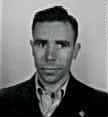
His record states:
"His work was good average and due to his keeness much improvement was shown. His part in all details he participated in was well carried out and he proved himself to be a reliable and thorough bomb aimer. His general conduct was very good as was his bearing and whenever required he was found to be punctual and reliable."
Flight Sergeant Everard Charles Graebner, aged 22, wireless operator/air gunner. He was the son of the Rev. Rudolph Graebner and Doris Graebner, of Perth, Western Australia and husband of Dorothy Jean Graebner, of Mount Lawley, Western Australia, and had one daughter, Jennifer. He had been working as a bank clerk and had served 13 months with the 3rd Field Regiment of the Volunteer Militia, before re-engaging with the RAAF on 16th January 1943, He was awarded his air gunner's badge in December 1943 and arrived in the UK on 13th March 1943. He was promoted to Flight Sergeant in June 1944 and posted to 21 OTU on 30th January 1945. His record records:
"Above average air gunner. A very keen and reliable aircrew member. A very high standard of efficiency was attained during OTU training"
.jpg?timestamp=1506674522277)
Flight Sergeant John Raymond Thomas, aged 20, wireless operator/air gunner. He was the son of John Robert and Beatrice Martha Thomas, of Mackay, Queensland, Australia.
Warrant Officer Charles Henry Harrison, aged 34, wireless operator/air gunner. He was the son of Charles and Mary Lillian Harrison, of South Melbourne, Victoria, Australia.
This was the last Wellington Mk III to be lost by a Bomber Command Operational Training Unit.
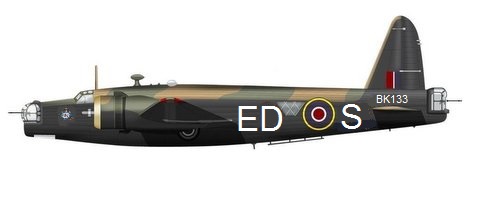
.jpg?timestamp=1555484057012)
23rd August 1945: De Havilland Mosquito B Mk XX KB194 from 16 Operational Training Unit took of from RAF Barford St John at 2046 on a training flight. It is believed that after losing control in cloud the aircraft broke up and crashed at 2104 at Heath Farm between Hook Norton and Great Rollright killing both aircrew:
Flying Officer George Mansell Proctor DFC, pilot, Royal New Zealand Air Force aged 22. He was the son of George and Annie Proctor, of Caversham, Dunedin, Otago, New Zealand. He was commissioned as a Pilot Officer on 4th August 1944 and promoted to Flying Officer in February 1945.
Flying Officer Keith Leslie Kelly DFC, navigator, Royal New Zealand Air Force aged 20. He was the son of Douglas and Mary Kelly of Kirwee, New Zealand. He was appointed as a Sergeant Navigator on 12th November 1943 and promoted to Flying Officer in May 1944.

Flying Officers Proctor and Kelly had flown their operational tours with 619 Squadron, RAF, being members of the same crew on at least 33 sorties, flying the Avro Lacaster Mk III 4 engined bomber. Both were awarded the Distinguished Flying Cross for their efforts. After 619 Squadron was disbanded they converted to the Mosquito at 16 OTU. Both men are buried in Oxford Botley Road cemetery.

.jpg?timestamp=1555484057012)
An Airspeed Oxford crash landed at Chipping Norton Relief Landing Ground
